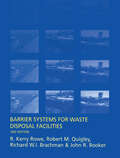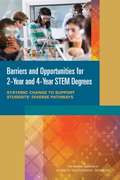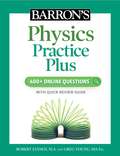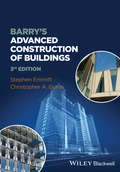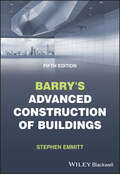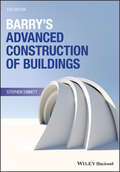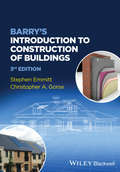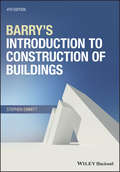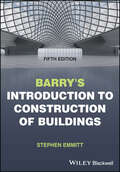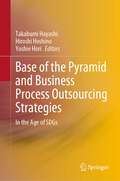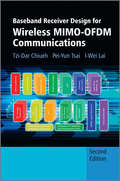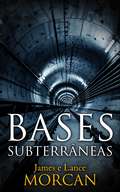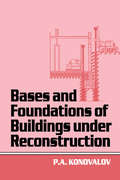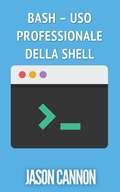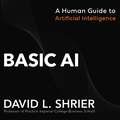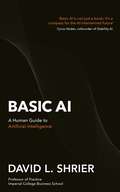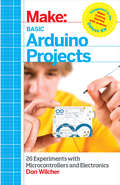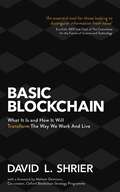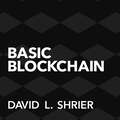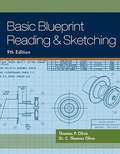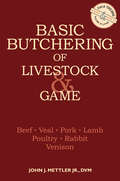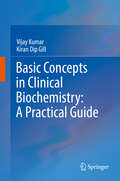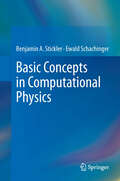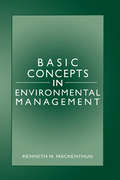- Table View
- List View
Barrier Systems for Waste Disposal Facilities
by J.R. Booker Richard Brachman R.M. Quigley R. Kerry RoweThe protection of groundwater and surface water from contamination by the escape of contaminant from waste disposal is now an important consideration in many countries of the world.This book deals with the design of 'barrier systems' which separate waste from the surrounding environment and which are intended to prevent contamination of both ground
Barriers and Opportunities for 2-Year and 4-Year STEM Degrees: Systemic Change to Support Students’ Diverse Pathways
by Engineering Medicine National Academies of SciencesNearly 40 percent of the students entering 2- and 4-year postsecondary institutions indicated their intention to major in science, technology, engineering, and mathematics (STEM) in 2012. But the barriers to students realizing their ambitions are reflected in the fact that about half of those with the intention to earn a STEM bachelor’s degree and more than two-thirds intending to earn a STEM associate’s degree fail to earn these degrees 4 to 6 years after their initial enrollment. Many of those who do obtain a degree take longer than the advertised length of the programs, thus raising the cost of their education. Are the STEM educational pathways any less efficient than for other fields of study? How might the losses be “stemmed” and greater efficiencies realized? These questions and others are at the heart of this study. Barriers and Opportunities for 2-Year and 4-Year STEM Degrees reviews research on the roles that people, processes, and institutions play in 2-and 4-year STEM degree production. This study pays special attention to the factors that influence students’ decisions to enter, stay in, or leave STEM majors—quality of instruction, grading policies, course sequences, undergraduate learning environments, student supports, co-curricular activities, students’ general academic preparedness and competence in science, family background, and governmental and institutional policies that affect STEM educational pathways. Because many students do not take the traditional 4-year path to a STEM undergraduate degree, Barriers and Opportunities describes several other common pathways and also reviews what happens to those who do not complete the journey to a degree. This book describes the major changes in student demographics; how students, view, value, and utilize programs of higher education; and how institutions can adapt to support successful student outcomes. In doing so, Barriers and Opportunities questions whether definitions and characteristics of what constitutes success in STEM should change. As this book explores these issues, it identifies where further research is needed to build a system that works for all students who aspire to STEM degrees. The conclusions of this report lay out the steps that faculty, STEM departments, colleges and universities, professional societies, and others can take to improve STEM education for all students interested in a STEM degree.
Barron's Physics Practice Plus: 400+ Online Questions and Quick Study Review
by Robert Jansen M.A. Greg Young M.S. Ed.Need quick review and practice to help you excel in Physics?Barron&’s Physics Practice Plus features more than 400 online practice questions and a concise review guide that covers the basics of Physics. Inside you&’ll find:Concise review on the basics of Physics—an excellent resource for students who want a quick review of the most important topicsAccess to 400+ online questions arranged by topic for customized practiceOnline practice includes answer explanations with expert advice for all questions plus scoring to track your progressThis essential guide is the perfect practice supplement for students and teachers!
Barry's Advanced Construction of Buildings
by Stephen Emmitt Christopher A. GorseRobin Barry's Construction of Buildings was first published in 1958 in 5 volumes, rapidly becoming a standard text on construction. In its current 2 volume format Barry remains hugely popular with both students and lecturers of construction and related disciplines.The third edition of Barry's Advanced Construction of Buildings expands and deepens your understanding of construction technology. It covers the construction of larger-scale buildings (primarily residential, commercial and industrial) constructed with load bearing frames, supported by chapters on fit-out and second fix, lifts and escalators, off-site construction and a new chapter on building obsolescence and revitalisation. Functional and performance requirements of the main building elements are emphasised throughout, as is building efficiency and meeting the challenges of limiting the environmental impact of buildings. You will find the text fully up to date with the latest building regulations and construction technologies.The new edition, with supporting material at www.wiley.com/go/barrysintroduction, is an ideal information source for developing a wider and deeper understanding of construction technology.
Barry's Advanced Construction of Buildings
by Stephen EmmittBARRY’S ADVANCED CONSTRUCTION OF BUILDINGS An up-to-date edition of the comprehensive guide to building practice Since 1958, Barry’s Construction of Buildings has served as a standard guide to building practices and construction skills. The second volume of this two-volume format, Barry’s Advanced Construction of Buildings builds on the introductory material of the first volume to offer readers a thorough grounding in construction and its various facets. Emphasizing large-scale buildings, particularly those with load-bearing frames in timber, concrete and steel, and supported by chapters on offsite construction, piling, envelopes to framed buildings, fit-out and second fix, lifts and escalators, building pathology, upgrading and demolition, this latest edition incorporates critical new material, including New questions in each chapter designed to enhance learning Updates throughout reflecting the latest building practices and professional knowledge A new focus on low-carbon construction Barry’s Advanced Construction of Buildings is an essential tool for any student working towards qualifications in building and construction, and a handy reference for construction professionals in any area.
Barry's Advanced Construction of Buildings (Wiley Desktop Editions Ser.)
by Stephen EmmittThe updated edition of the authoritative and comprehensive guide to construction practice The revised fourth edition of Barry’s Advanced Construction of Buildings expands on the resource that has become a standard text on the construction of buildings. The fourth edition covers the construction of larger-scale buildings (primarily residential, commercial and industrial) constructed with load bearing frames in timber, concrete and steel; supported by chapters on offsite construction, piling, envelopes to framed buildings, fit-out and second fix, lifts and escalators, building pathology, upgrading and demolition. The author covers the functional and performance requirements of the main building elements as well as building efficiency and information on meeting the challenges of limiting the environmental impact of buildings. Each chapter includes new “at a glance” summaries that introduce the basic material giving a good understanding of the main points quickly and easily. The text is fully up to date with the latest building regulations and construction technology. This important resource: Covers design, technology, offsite construction, site assembly and environmental issues of larger-scale buildings including primarily residential, commercial and industrial buildings constructed with load bearing frames Highlights the concept of building efficiency, with better integration of the topics throughout the text Offers new “at a glance” summaries at the beginning of each chapter Is a companion to Barry's Introduction to Construction of Buildings, fourth edition Written for undergraduate students and those working towards similar NQF level 5 and 6 qualifications in building and construction, Barry’s Advanced Construction of Buildings is a practical and highly illustrated guide to construction practice. It covers the materials and technologies involved in constructing larger scale buildings.
Barry's Introduction to Construction of Buildings
by Stephen Emmitt Christopher A. GorseThis new edition of Barry's Introduction to Construction of Buildings adds considerable new material but remains based on the original concept of explaining construction technology through key functional/performance requirements for the main elements common to all buildings. Of particular note in this new edition are a fully integrated approach to environmental issues and construction sustainability.The rest of the material has been updated as required, with particular attention paid to the illustrations. With over 150 new photographs and many revised figures, plus a supporting website at www.wiley.com/go/barrysintroduction, students learning the fundamentals of building and construction on undergraduate and other NQF level 5 - 6 courses will find this the ideal introduction to the subject.
Barry's Introduction to Construction of Buildings
by Stephen EmmittAn authoritative, well-established, comprehensive, practical, and highly illustrated guide to construction practice Based mainly on domestic and residential buildings—and filled with extensive illustrations throughout—this concise text is the ideal introduction to the subject of building construction. It provides the basic material that readers need in order to understand the construction process for the majority of low rise buildings. The book explains construction technology through the key functional and performance requirements for the main elements common to all buildings. With a strong focus on building efficiency and meeting the challenges posed by limiting the environmental impact of buildings, and new “at a glance” summaries allowing you to grasp the salient points of each chapter, readers will find the text fully up to date with the latest building regulations and construction technology. Barry’s Introduction to Construction of Buildings, Fourth Edition starts by taking an in-depth look at the construction process and general principles of construction. It then offers comprehensive chapter coverage of site analysis, set-up, drainage and scaffolding; ground stability and foundations; floors, walls, doors, windows, roofs, stairs, and ramps; surface finishes; internal environment and energy supply; and water supply and sanitation. Deals with design, technology, site assembly, and environmental issues of domestic and residential buildings Thoroughly updated, with particular attention paid to the concept of building efficiency and improved integration of the topics covered to match current student needs New “at a glance” summaries at the beginning of each chapter A companion to Barry's Advanced Construction of Buildings, Fourth Edition Barry’s Introduction to Construction of Buildings is an excellent source of information for undergraduate students and those working towards similar NQF level 5 and 6 qualifications in building and construction.
Barry's Introduction to Construction of Buildings
by Stephen EmmittBARRY’S INTRODUCTION TO CONSTRUCTION OF BUILDINGS Authoritative, well established, comprehensive, practical, and highly illustrated guide to construction practice Barry’s Introduction to Construction of Buildings provides the basic material an undergraduate student will need to understand how the majority of low-rise buildings are constructed. The text explains construction technology through key functional and performance requirements for the main elements common to all buildings. The material in the Fifth Edition has been updated to ensure it covers the latest building regulations and current construction technology, with particular attention paid to the decisions required on what and how to build to achieve a low carbon, resilient built environment. Design, technology, site assembly, and environmental issues are all covered, showing how buildings that are more efficient, with lower embodied carbon, are constructed. New ‘in chapter’ questions better facilitate self-reflection and learning. Barry’s Introduction to Construction of Buildings contains information on: General principles of construction, regulations and approvals, making choices and sources of information, and responding to climate change Site analysis, setup, security, bedrock and soil types, ground stability, drainage, strip, pad, and raft foundations and scaffolding Functional requirements for floors, including ground-supported concrete floor slabs, timber upper floors, floor finishes, and suspended timber ground floors Pitched roofs and their coverings, sheet metal covering to low-pitched roofs, flat roofs, thermal insulation in flat roofs, parapet walls, and green roofs Barry’s Introduction to Construction of Buildings is an ideal learning resource for undergraduate students and those working towards similar NQF level 5 and 6 qualifications in building and construction. This title is a companion to Barry’s Advanced Construction of Buildings.
Base of the Pyramid and Business Process Outsourcing Strategies: In the Age of SDGs
by Takabumi Hayashi Hiroshi Hoshino Yoshie HoriThe major objective of this book is to introduce social business models to face the challenge of social issues in emerging countries. Each chapter clarifies business strategies based on diligent field surveys in developing nations, focusing on Bangladesh and the Philippines, where social issues in the age of Sustainable Development Goals (SDGs) are concentrated. The field surveys enable the effective construction of a sophisticated hybrid value chain by connecting a sustainable business ecosystem of local value chains with global value chains. Joint social business entities formed between local NGOs and foreign companies, multinational corporations with global value chains, among others, appear to be the keystones. In Part I, the case of Grameen Euglena in Bangladesh and that of Sari-Sari stores leveraging micro-financing in the Philippines, along with other interesting cases, are analyzed as effective social business models. Analysis also shows that the IT service industry in emerging countries helps to enlarge formal sectors so as to absorb younger generations into informal sectors. The e-health service business in Bangladesh and the business process outsourcing (BPO) IT service industry in the Philippines are examined in each part of the book. Part II, particularly, shows that IT and the digital technology-based service industry can lead to a new industrial development path in these countries instead of the conventional one based on manufacturing. In other words, digital technology-based service industries, as formal sectors, can absorb working people from informal sectors. As a result, poverty issues which form a key issue in SDGS will be alleviated. This book is highly recommended not only to academicians but also to businesspeople who seek an in-depth and up-to-date overview of new sustainable and inclusive businesses in the age of SDGs.
Baseband Receiver Design for Wireless MIMO-OFDM Communications (Wiley - IEEE)
by I-Wei Lai Pei-Yun Tsai Tzi-Dar ChiuehThe Second Edition of OFDM Baseband Receiver Design for Wirless Communications, this book expands on the earlier edition with enhanced coverage of MIMO techniques, additional baseband algorithms, and more IC design examples. The authors cover the full range of OFDM technology, from theories and algorithms to architectures and circuits. The book gives a concise yet comprehensive look at digital communication fundamentals before explaining signal processing algorithms in receivers. The authors give detailed treatment of hardware issues - from architecture to IC implementation. Links OFDM and MIMO theory with hardware implementation Enables the reader to transfer communication received concepts into hardware; design wireless receivers with acceptable implemntation loss; achieve low-power designs Covers the latest standards, such as DVB-T2, WiMax, LTE and LTE-A Includes more baseband algorithms, like soft-decoding algorithms such as BCJR and SOVA Expanded treatment of channel models, detection algorithms and MIMO techniques Features concrete design examples of WiMAX systems and cognitive radio apllications Companion website with lecture slides for instructors Based on materials developed for a course in digital communication IC design, this book is ideal for graduate students and researchers in VLSI design, wireless communications, and communications signal processing. Practicing engineers working on algorithms or hardware for wireless communications devices will also find this to be a key reference.
Bases Subterrâneas
by James Morcan Lance Morcan Anabela SousaBases Subterrâneas revela detalhes sobre instalações subterrâneas nos Estados Unidos e ao redor do mundo, confirmadas e rumorejadas. Contendo raras provas fotográficas, bem como citações pouco conhecidas de figuras chave do governo, lança argumentos convincentes para a existência de um enorme mundo oculto sob a superfície da terra.
Bases and Foundations of Building Under Reconstruction
by P.A. KonovalovTranslated from the Russian, this English edition of the text has been revised and updated. It covers such topics as: reasons for strengthening bases and foundations of buildings; behavioural features and foundations of in-service buildings; and stabilization of soils.
Bash – Uso Professionale Della Shell
by Eugenia Franzoni Jason CannonSe vi siete mai detti "C'è un modo migliore per fare questa cosa", allora continuate a leggere.Dato che ho usato la shell Bash per oltre 15 anni quasi tutti i giorni, ho accumulato diversi "trucchi" da linea di comando che mi hanno fatto risparmiare tempo e frustrazioni. "Bash - Uso professionale della shell" è una raccolta di 10 tecniche che potete utilizzare subito per aumentare la vostra efficienza sulla linea di comando.Ecco cosa imparerete leggendo "Bash - Uso professionale della shell": Suggerimento 1: Autocompletamento con Tab Suggerimento 2: Passare alla directory precedente Suggerimento 3: Riutilizzare l'ultimo elemento della linea di comando precedente Suggerimento 4: Eseguire di nuovo un comando che inizia con una data stringa Suggerimento 5: Sostituzione dei comandi Suggerimento 6: Usare un ciclo sulla linea di comando Suggerimento 7: Eseguire di nuovo il comando precedente con privilegi di root Suggerimento 8: Eseguire di nuovo il comando sostituendo una stringa Suggerimento 9: Riusare una parola sulla stessa linea di comando Suggerimento 10: Correggere errori di digitazione ed abbreviare i comandi lunghi con degli alias
Basic AI: A Human Guide to Artificial Intelligence
by David ShrierIn Basic AI, leading futurist David L. Shrier delves deep into the rapidly advancing world of artificial intelligence, delivering fascinating insights and exploring the impact this powerful technology will have on our lives and world.Artificial intelligence is driving workforce disruption on a scale not seen since the Industrial Revolution. In schools and universities, AI technology has forced a re-evaluation of the way students are taught and assessed. Meanwhile ChatGPT has become a cultural phenomenon, reaching 100 million users and attracting a $10 billion dollar investment in its parent company OpenAI. The race to dominate the generative AI market is accelerating at breakneck speed, inspiring breathless headlines and immense public interest.Basic AI provides a rare window into a frontier area of computer science that will change everything about how you live and work. Listen to this book and better understand how to succeed in the AI-enabled future.
Basic AI: A Human Guide to Artificial Intelligence
by David ShrierIn Basic AI, leading futurist David L. Shrier delves deep into the rapidly advancing world of artificial intelligence, delivering fascinating insights and exploring the impact this powerful technology will have on our lives and world.Artificial intelligence is driving workforce disruption on a scale not seen since the Industrial Revolution. In schools and universities, AI technology has forced a re-evaluation of the way students are taught and assessed. Meanwhile ChatGPT has become a cultural phenomenon, reaching 100 million users and attracting a $10 billion dollar investment in its parent company OpenAI. The race to dominate the generative AI market is accelerating at breakneck speed, inspiring breathless headlines and immense public interest.Basic AI provides a rare window into a frontier area of computer science that will change everything about how you live and work. Read this book and better understand how to succeed in the AI-enabled future.
Basic Arduino Projects: 26 Experiments with Microcontrollers and Electronics
by Don WilcherThis companion book to MakerShed's Ultimate Arduino Microcontroller Pack provides 26 clearly explained projects that you can build with this top-selling kit right away--including multicolor flashing lights, timers, tools for testing circuits, sound effects, motor control, and sensor devices.With the Ultimate Arduino Microcontroller Pack, you'll find everything from common components such as resistors and capacitors to specialized sensors and actuators like force-sensing resistors and motors. The kit also features the Arduino Uno Microcontroller and a MakerShield, the definitive prototyping shield for Arduino.Build 26 cool mini Arduino projects and gadgetsWork on projects that are both instructive and have practical applicationGet circuit diagrams and detailed instructions for building each projectUnderstand circuit design and simulation with easy-to-use tools
Basic Blockchain: What It Is and How It Will Transform the Way We Work and Live
by David ShrierThe only book you need to understand blockchain: what it is, how it works and how it will transform business, society and our everyday lives. Basic Blockchain is an accessible, non-technical introduction to a revolutionary technology.'Makes it easy for the average business executive to understand blockchain' -- Chris Larsen, founder and chairman, Ripple'An essential tool for those looking to distinguish information from noise' -- Eva Kaili, MEP and Chair of The Committee for the Future of Science and TechnologyA revolution is under way across the globe, yet very few people understand it. Basic Blockchain will explain everything you need to know to understand the technology that will soon disrupt and revolutionise everything from financial and health services to the property market and how we vote.Born of an obscure body of research on game theory developed by NASA, originally championed by drug dealers seeking to launder ill-gotten gains, accelerated by entrepreneurs seeking to improve financial access for the poor, funded by giant corporate interests attracted to the potential for billions of dollars of cost savings, blockchain heralds a new era of financial inclusion, legal inclusion for the dispossessed and lower prices for consumers. In short, it will enact radical change on our lives.In this book, David L. Shrier, one of MIT and Oxford University's leading futurists, explains for the general reader:- The history of blockchain, its apocryphal progenitor Satoshi Nakamoto and the socioeconomic context of its origins in the 2008 financial crisis.- How blockchain works, including the core technologies that drive it such as cryptographic hashes and network theory, all described in simple, understandable terms.- The potential of blockchain, including its impact on our jobs, industry and society as a whole. Blockchain will disrupt and transform our world in profound ways. This accessible book, written by a global authority on blockchain, is the essential introduction to the next technological revolution.
Basic Blockchain: What It Is and How It Will Transform the Way We Work and Live
by David ShrierThe only book you need to understand blockchain: what it is, how it works and how it will transform business, society and our everyday lives. Basic Blockchain is an accessible, non-technical introduction to a revolutionary technology.'Makes it easy for the average business executive to understand blockchain' -- Chris Larsen, founder and chairman, Ripple'An essential tool for those looking to distinguish information from noise' -- Eva Kaili, MEP and Chair of The Committee for the Future of Science and TechnologyA revolution is under way across the globe, yet very few people understand it. Basic Blockchain will explain everything you need to know to understand the technology that will soon disrupt and revolutionise everything from financial and health services to the property market and how we vote.Born of an obscure body of research on game theory developed by NASA, originally championed by drug dealers seeking to launder ill-gotten gains, accelerated by entrepreneurs seeking to improve financial access for the poor, funded by giant corporate interests attracted to the potential for billions of dollars of cost savings, blockchain heralds a new era of financial inclusion, legal inclusion for the dispossessed and lower prices for consumers. In short, it will enact radical change on our lives.In this book, David L. Shrier, one of MIT and Oxford University's leading futurists, explains for the general reader:- The history of blockchain, its apocryphal progenitor Satoshi Nakamoto and the socioeconomic context of its origins in the 2008 financial crisis.- How blockchain works, including the core technologies that drive it such as cryptographic hashes and network theory, all described in simple, understandable terms.- The potential of blockchain, including its impact on our jobs, industry and society as a whole. Blockchain will disrupt and transform our world in profound ways. This accessible book, written by a global authority on blockchain, is the essential introduction to the next technological revolution.
Basic Blockchain: What It Is and How It Will Transform the Way We Work and Live
by David ShrierThe only book you need to understand blockchain: what it is, how it works and how it will transform business, society and our everyday lives. Basic Blockchain is an accessible, non-technical introduction to a revolutionary technology.'Makes it easy for the average business executive to understand blockchain' -- Chris Larsen, founder and chairman, Ripple'An essential tool for those looking to distinguish information from noise' -- Eva Kaili, MEP and Chair of The Committee for the Future of Science and TechnologyA revolution is under way across the globe, yet very few people understand it. Basic Blockchain will explain everything you need to know to understand the technology that will soon disrupt and revolutionise everything from financial and health services to the property market and how we vote.Born of an obscure body of research on game theory developed by NASA, originally championed by drug dealers seeking to launder ill-gotten gains, accelerated by entrepreneurs seeking to improve financial access for the poor, funded by giant corporate interests attracted to the potential for billions of dollars of cost savings, blockchain heralds a new era of financial inclusion, legal inclusion for the dispossessed and lower prices for consumers. In short, it will enact radical change on our lives.In this book, David L. Shrier, one of MIT and Oxford University's leading futurists, explains for the general reader:- The history of blockchain, its apocryphal progenitor Satoshi Nakamoto and the socioeconomic context of its origins in the 2008 financial crisis.- How blockchain works, including the core technologies that drive it such as cryptographic hashes and network theory, all described in simple, understandable terms.- The potential of blockchain, including its impact on our jobs, industry and society as a whole. Blockchain will disrupt and transform our world in profound ways. This accessible book, written by a global authority on blockchain, is the essential introduction to the next technological revolution.
Basic Blueprint Reading and Sketching
by Thomas P. Olivo C. Thomas OlivoFor over 50 years, Basic Blueprint Reading and Sketching has been an international best-seller, with close to $500,000 in sales and THE definitive resource for blueprint reading. The newly revised 9th edition of Basic Blueprint Reading and Sketching continues the traditions in helping to readers achieve competence in reading and sketching technical drawings. This classic interactive book/workbook will help users develop skills in reading and interpreting industrial drawings and preparing basic to advanced technical sketches. This book will provide them with basic principles, concepts, ANSI and SI Metric drafting symbols and standards, terminology, manufacturing process notes, and other related technical information contained on a mechanical or CAD drawing. Each unit features a basic principle and at least one blueprint and assignment that encourages students to practice newly learned skills. This edition contains coverage of the latest ANSI, ISO, AWS and ASME standards.
Basic Butchering of Livestock & Game: Beef, Veal, Pork, Lamb, Poultry, Rabbit, Venison
by John J. MettlerThis guide takes the mystery out of butchering, covering everything you need to know to produce your own expert cuts of beef, venison, pork, lamb, poultry, and small game. John J. Mettler Jr. provides easy-to-follow instructions that walk you through every step of the slaughtering and butchering process, as well as plenty of advice on everything from how to dress game in a field to salting, smoking, and curing techniques. You’ll soon be enjoying the satisfyingly superior flavors that come with butchering your own meat.
Basic Concepts in Clinical Biochemistry: A Practical Guide
by Vijay Kumar Kiran Dip GillThis book is a practical guidebook in biochemistry, for medical as well as life sciences' students. The book covers reference values, sample collection procedure and detailed protocol to perform experiments. Each experiment starts with a brief introduction of the protocol, followed by specimen requirements and procedure. The procedures are presented in a very lucid manner and discuss details of calculations and clinical interpretations,The book is divided into 29 chapters, It offers references, general guidelines and abbreviations and provides principles and procedures of clinical biochemistry tests, along with their diagnostic importance.
Basic Concepts in Computational Physics
by Ewald Schachinger Benjamin A. SticklerWith the development of ever more powerful computers a new branch of physics and engineering evolved over the last few decades: Computer Simulation or Computational Physics. It serves two main purposes:- Solution of complex mathematical problems such as, differential equations, minimization/optimization, or high-dimensional sums/integrals.- Direct simulation of physical processes, as for instance, molecular dynamics or Monte-Carlo simulation of physical/chemical/technical processes.Consequently, the book is divided into two main parts: Deterministic methods and stochastic methods. Based on concrete problems, the first part discusses numerical differentiation and integration, and the treatment of ordinary differential equations. This is augmented by notes on the numerics of partial differential equations. The second part discusses the generation of random numbers, summarizes the basics of stochastics which is then followed by the introduction of various Monte-Carlo (MC) methods. Specific emphasis is on MARKOV chain MC algorithms. All this is again augmented by numerous applications from physics. The final two chapters on Data Analysis and Stochastic Optimization share the two main topics as a common denominator. The book offers a number of appendices to provide the reader with more detailed information on various topics discussed in the main part. Nevertheless, the reader should be familiar with the most important concepts of statistics and probability theory albeit two appendices have been dedicated to provide a rudimentary discussion.
Basic Concepts in Environmental Management
by Kenneth M. MackenthunEnvironmental professionals are (and will continue to be) under increased pressure to become more knowledgeable of environmental management issues.Basic Concepts in Environmental Management fulfills the long-standing need for fundamental knowledge-especially concerning government regulations on environmental and natural resource protection.As a leading environmental professional and consultant since the 1940s, Kenneth M. Mackenthun offers a unique perspective on the breadth, scope, and ever-constant change in environmental legislation at the federal, state, and local levels... and what those guidelines signify for industry and citizens alike.By maintaining an awareness of existing and forthcoming laws, environmentalists can substantially enhance their career potential-and be in a better position to protect the land, air, and sea. The starting point for that knowledge: Basic Concepts in Environmental Management.
